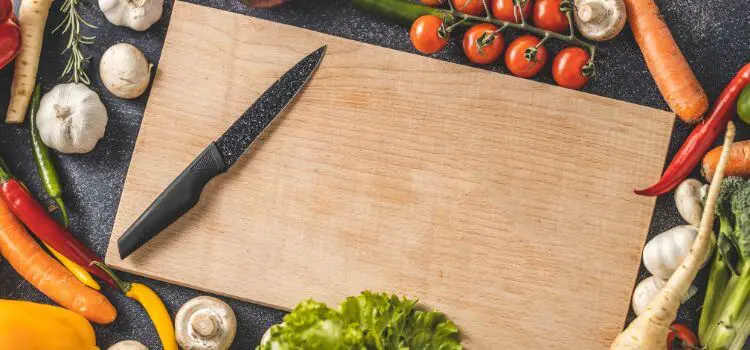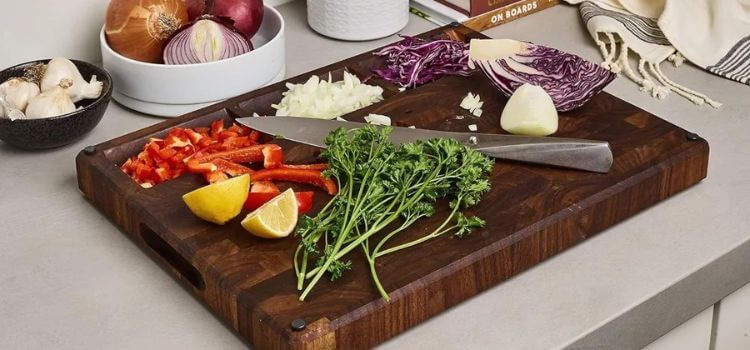As an Amazon Associate, I earn from qualifying purchases

The relationship between cutting boards and knife sharpness is akin to that of a dance partner. A cutting board not only supports your food prep but also interacts with your knife every time it slices, chops, or dices. Knowing which cutting boards are knife-friendly can help you preserve those razor-sharp edges and save time and money on sharpening.
Types of Cutting Boards and Their Impact on Knives
Wood Cutting Boards
Wood cutting boards are often considered the gold standard in many kitchens. They offer a natural, knife-friendly surface that is gentler on blades. Woods like maple, cherry, and walnut have just the right amount of give, which helps maintain the sharpness of your knife over time. Wood boards also have self-healing properties, meaning small cuts and nicks close up, keeping the surface smooth. However, these boards require regular maintenance, including oiling, to prevent warping and cracking.
Plastic Cutting Boards
Plastic cutting boards are popular due to their affordability and ease of cleaning. They’re lightweight and can be tossed in the dishwasher, making them convenient for busy cooks. However, their hardness can vary, and some plastic boards are hard enough to contribute to knife dulling. Moreover, as plastic boards get scarred over time, they can harbor bacteria in the grooves, which is a consideration for those focused on kitchen hygiene.
Bamboo Cutting Boards
Bamboo boards are eco-friendly and very durable, but their hardness can be a double-edged sword. While they are resistant to knife marks, this same hardness can dull knives more quickly compared to wood. Bamboo contains silica, a natural substance that can wear down knife edges. Despite this, their environmental benefits and aesthetic appeal continue to attract many home cooks.
Glass Cutting Boards
Glass cutting boards are often chosen for their modern look and ease of cleaning. However, they are notoriously hard on knives and can dull them very rapidly. While glass boards are hygienic and won’t absorb juices or odors, they should be avoided if you care about maintaining sharp knife edges. They’re best used for tasks other than cutting, such as serving cheese or displaying hors d’oeuvres.
The Science Behind Knife Dulling

- Material Hardness: The hardness of a cutting board material is a significant factor in how it affects knife sharpness. Softer materials like wood provide a cushion for the knife edge, reducing dulling. Harder materials, such as glass or even some plastics, lack this give and can cause microchips in the blade, leading to dullness. When selecting a board, consider the material’s hardness relative to your knife’s needs.
- Cutting Technique: Your cutting technique also plays a role in how quickly a knife dulls. Proper techniques, such as slicing rather than chopping, minimize the force and impact on the knife edge, preserving sharpness. Additionally, using the right knife for the task—like a serrated knife for bread or a chef’s knife for vegetables—can help maintain its sharpness longer.
Tips for Maintaining Knife Sharpness
- Regular Sharpening and Honing: Regular sharpening and honing are essential to keeping knives in peak condition. Honing aligns the blade’s edge, while sharpening removes material to create a new edge. Investing in a good quality honing steel and a sharpening stone or electric sharpener will extend the life of your knives.
- Selecting the Right Cutting Board for Your Needs: Choosing the right cutting board is crucial for knife care. If preserving knife sharpness is a priority, opt for a wood cutting board, especially those made from end grain. End grain boards are particularly gentle on knives as they allow the blade to slide between the wood fibers rather than cutting against them.
- Proper Knife Handling Techniques: Practicing proper knife handling techniques is another way to maintain sharpness. Use a soft back-and-forth slicing motion rather than a hard chopping action, and avoid twisting the knife in the food. Additionally, store your knives properly—preferably in a knife block or on a magnetic strip—to protect the edges.
Conclusion
In the delicate balance between cutting board use and knife care, knowledge is key. While some cutting boards can dull knives more quickly than others, understanding the interaction between board material and knife edge can guide you in making informed choices.
Regular maintenance, coupled with the right board selection and cutting techniques, will help keep your knives sharp and your cooking efficient. So, the next time you’re in the kitchen, remember that the right cutting board can be just as important as the knife in your hand—choose wisely and your knives will thank you.
FAQ
What cutting board will not dull knives?
End grain wooden cutting boards are ideal for maintaining knife sharpness. Their surface allows knife blades to slide between the wood fibers, reducing resistance and wear on the blade. Other knife-friendly options include soft plastic boards, which are gentle on knives while offering easy maintenance and affordability.
Do cutting boards make knives dull?
Yes, cutting boards can dull knives over time, depending on the material. Hard surfaces like glass and some plastics are particularly abrasive, causing quicker dulling. Softer materials like wood or soft plastic are preferred as they offer less resistance, helping to preserve the knife’s edge longer.
Are wooden cutting boards bad for knives?
No, wooden cutting boards are generally beneficial for knives. They are soft enough to protect blade edges, minimizing dulling. Woods like maple and walnut are particularly favorable due to their perfect balance of hardness and knife-friendliness. Regular maintenance, such as oiling, helps preserve both the board and knife.
As an Amazon Associate, I earn from qualifying purchases